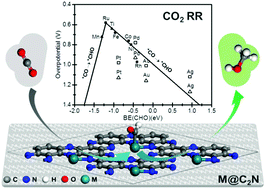C2N-graphene supported single-atom catalysts for CO2 electrochemical reduction reaction: mechanistic insight and catalyst screening†
Abstract
Single-atom catalysts (SACs) have emerged as an excellent platform for enhancing catalytic performance. Inspired by the recent experimental synthesis of nitrogenated holey 2D graphene (C2N-h2D) (Mahmood et al., Nat. Commun., 2015, 6, 6486–6493), we report density functional theory calculations combined with computational hydrogen electrode model to show that C2N-h2D supported metal single atoms (M@C2N) are promising electrocatalysts for CO2 reduction reaction (CO2 RR). M confined at pyridinic N6 cavity promotes activation of inert O![[double bond, length as m-dash]](https://www.rsc.org/images/entities/char_e001.gif) C
C![[double bond, length as m-dash]](https://www.rsc.org/images/entities/char_e001.gif) O bonds and subsequent protonation steps, with *COOH → *CO → CHO predicted to be the primary pathway for producing methanol and methane. It is found that *CO + H+ + e− → *CHO is most likely to be the potential determining step; breaking the scaling relation of *CO and *CHO binding on M@C2N SACs may simply be a rare event that is sensitively controlled by the detailed geometry of the adsorbate. Among twelve metals screened, M@C2N SACs where M = Ti, Mn, Fe, Co, Ni, Ru were identified to be effective in catalyzing CO2 RR with lowered overpotentials (0.58 V–0.80 V).
O bonds and subsequent protonation steps, with *COOH → *CO → CHO predicted to be the primary pathway for producing methanol and methane. It is found that *CO + H+ + e− → *CHO is most likely to be the potential determining step; breaking the scaling relation of *CO and *CHO binding on M@C2N SACs may simply be a rare event that is sensitively controlled by the detailed geometry of the adsorbate. Among twelve metals screened, M@C2N SACs where M = Ti, Mn, Fe, Co, Ni, Ru were identified to be effective in catalyzing CO2 RR with lowered overpotentials (0.58 V–0.80 V).



 Please wait while we load your content...
Please wait while we load your content...